We round up two of the rarest hot hatch icons in Singapore - the MINI JCW GP and Renault Mégane Trophy - in search of the ultimate front-wheel drive thrills.
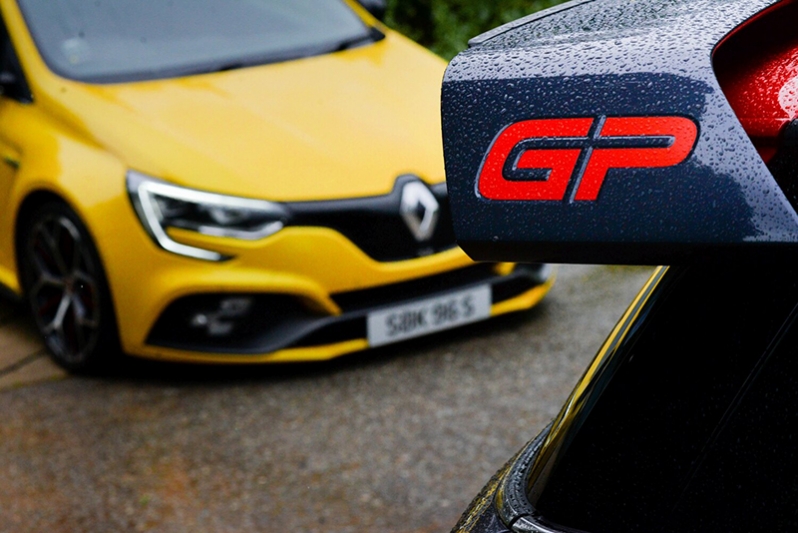
As a result, it’s not surprising that we almost never get the chance to present to you, dear readers, the kind of daydream-inspiring metal that our UK counterparts regularly do; today is different, however.
Apart from the VW Golf GTI and Honda Civic Type R, no other cars can lay claim to being as indelible a part of the 21st Century hot hatch zeitgeist as the reincarnated Mini and the Renault Megane RS. The three generations of each have generally been fabulous even in standard form, but it’s their apex, most focused iterations that have most vividly captured the imagination - the John Cooper Works GPs in the British/German corner, and the R26.R and Trophy Rs in the French one.
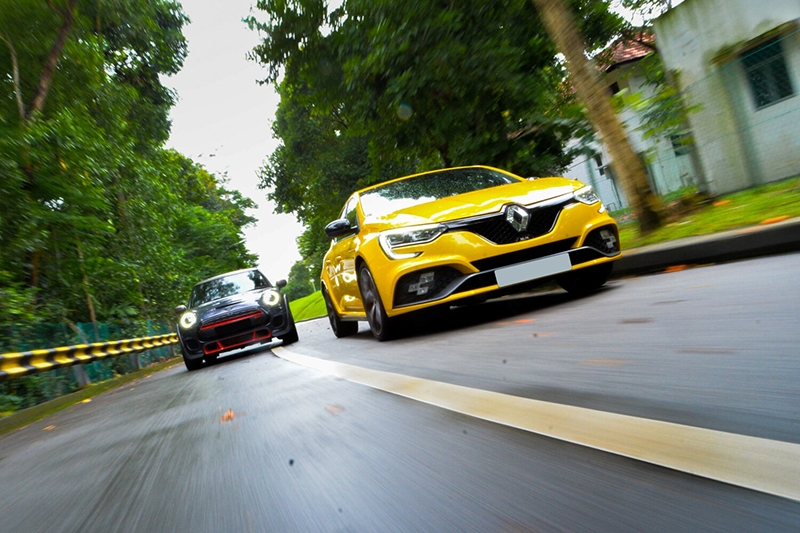
The elephant in the room of course is that we don’t have a Trophy R on hand - there’s only one on the island and we can’t envision any more making their way here, seeing as they go for BMW M2 Competition/Toyota GR Supra money (about S$300k). We do however, have the next best thing, a Megane RS Trophy. Alright alright, it’s not a limited edition like the Trophy R, but perhaps that’s not such a bad thing; numerous reviews out of the UK have noted that in addition to the cost, the Trophy R is probably too hardcore to be effective on the road, an important point considering how infrequently Singaporeans are able to take to the track. Besides, the Trophy itself is a rare beast too, one of a staggering two in Singapore. Next to that, the Mini JCW GP seems positively dime a dozen, with eight having found homes here.
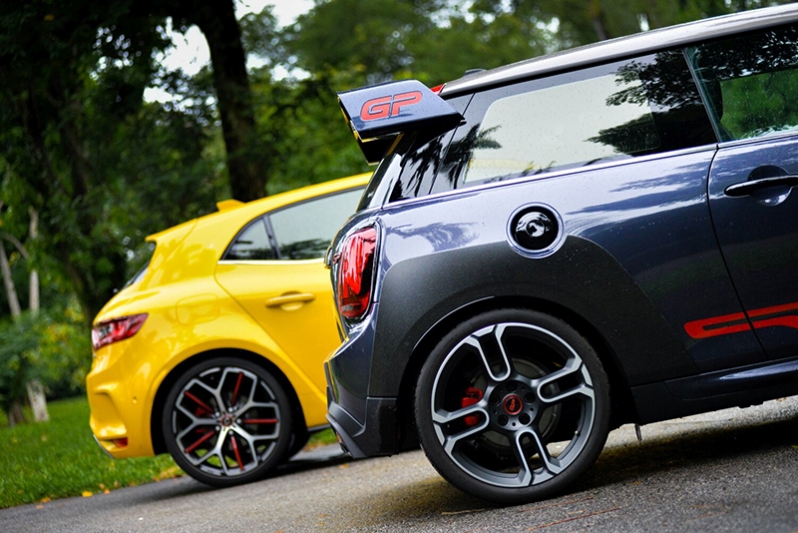
Not that a Trophy owner would be able to easily flaunt it without having to resort to outright shouting to the world about it; only the geekiest of car nerds would twig the red flashes on the new 19-inch wheels, red calipers for the new bi-material Brembo brakes, and “Trophy” script on the swoopy “blade” in the front bumper. The rest of it is identical to the standard Megane RS, but that’s no bad thing as the car’s purposeful-looking intakes and voluptuous hips scream aggression without being gaudy (looking at you, FK8 Civic Type R), and the gorgeously eye-catching Liquid Yellow paint almost seems to radiate its own glow.
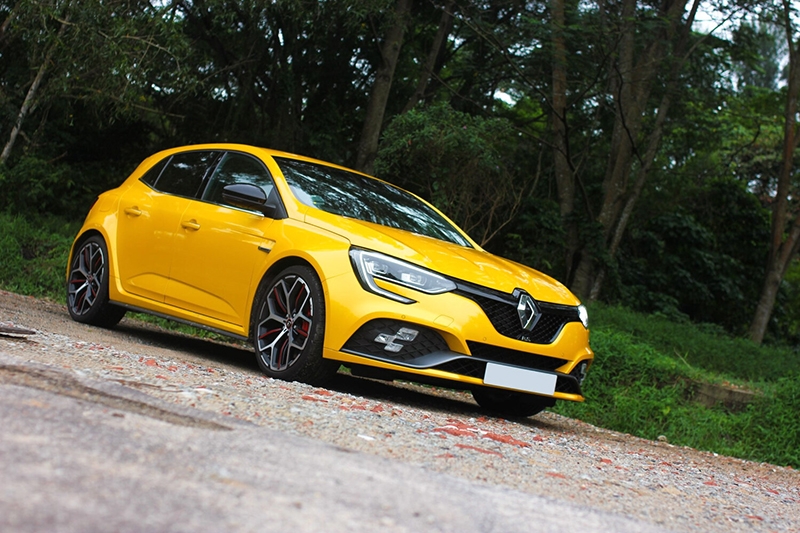
In comparison, the Mini’s flamboyance outshines that of even David Bowie at his ‘70s Ziggy Stardust best - war paint, shoulder pads and all. Red lipstick adorns a front end with a chin splitter that’s as sharp as the Thin White Duke’s himself, tacked-on carbonfibre wheelarch extensions (apparently using material recycled from i3 and i8 production) accommodate a 40mm wider track, and the dual-plane bisected rear wing looks like it was stolen straight off a concept car. It does retain trademark Mini GP cues like the Racing Grey paint and four-spoke wheels, but this is far and away the wildest thing to have ever rolled out of the Oxford factory.
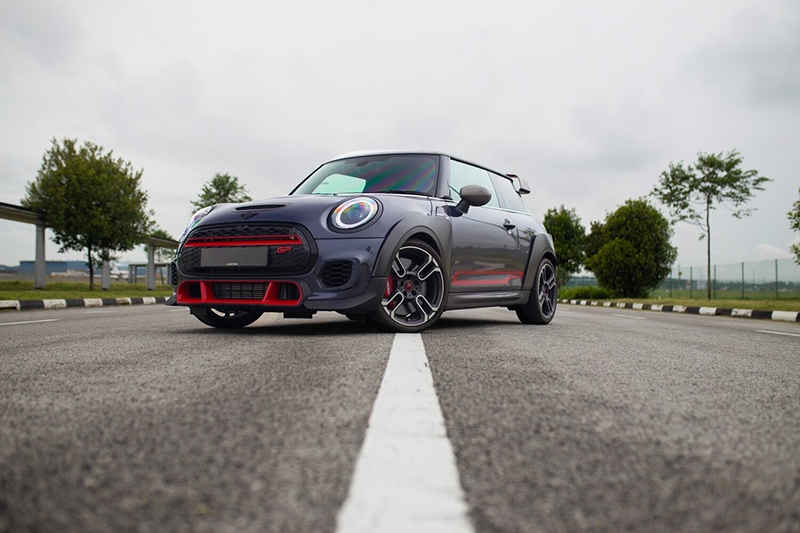
For all the barminess of the exterior, it’s a surprise of a different kind when you open the Mini’s door to get in. Where’s the drama? Where’s the lunacy and sense of focused purpose? There are a number of distinguishing features of course: the rather plain semi-digital instrument display lifted from the Mini Electric, the 3D-printed dashboard trim with the car’s serial number, and the 3D-printed metal shift paddles and 12 o’clock marker which when tapped go dink with the heftiness of a solid ingot.
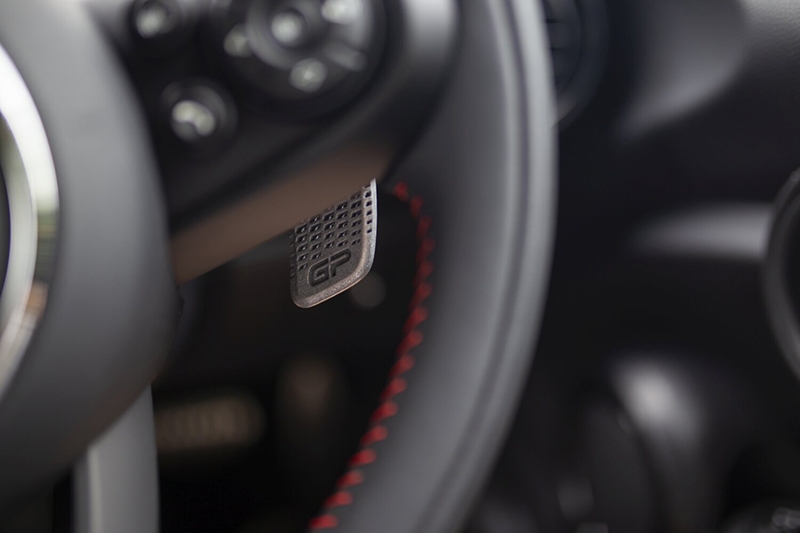
Apart from that though, there isn’t really much else that sets it apart from the regular JCW - the supportive and grippy sports seats are still there, as is the typically cheeky Mini architecture, but unless you’re paying close attention to the baseball glove stitching or turned your head to look at the bright red cross-brace occupying the space where the rear seats used to be, the overall impression is one of slightly underwhelming drabness, hardly the sort of environment that would have you raring to terrorise the tarmac.
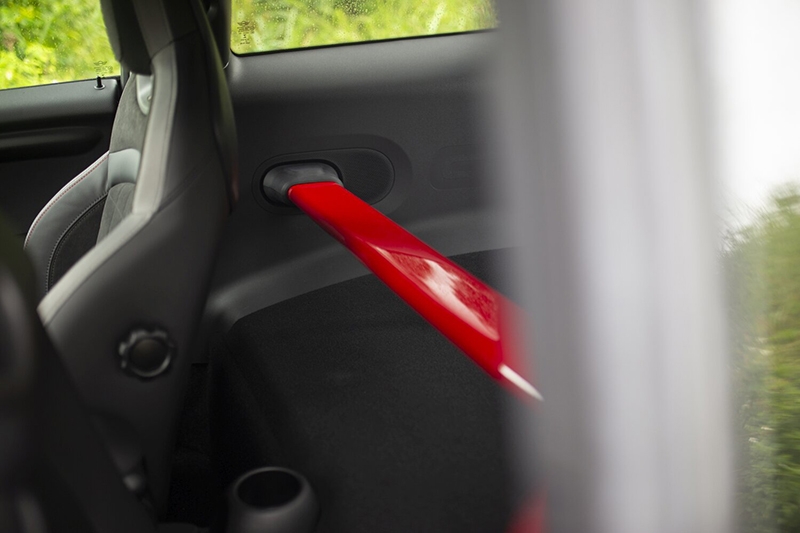
Not so the Trophy; despite its almost total lack of changes compared to the base RS (just the addition of optional Alcantara Recaro bucket seats), there’s still a much racier vibe to its cabin overall. There’s a half-Alcantara steering wheel, a race car-like instrument display mode, and all manner of telemetry readouts you can configure on the infotainment screen. But undoubtedly the biggest contribution to the Trophy’s cabin’s character is made by the Recaros themselves - hugging your body without constricting it, while at the same time providing sublime lumbar support. That the Trophy serves up such a tantalising amuse bouche to the driving experience ahead is testament to how right Renaultsport got the recipe with the base Megane RS in the first place.
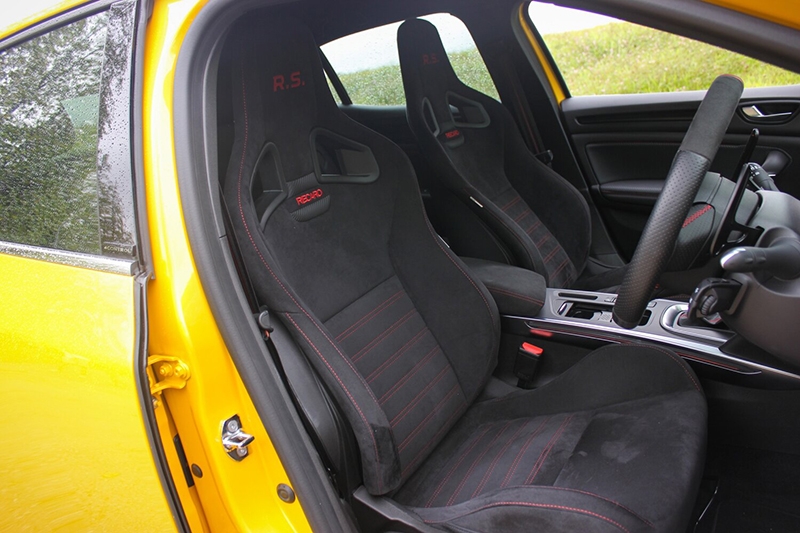
Walking up to the Trophy, it’s hard to ignore the pattering in my chest and the slight excited dizziness in my head. Driving the regular Megane RS a couple years back was a transcendental experience for me, its supernatural agility completely tearing up and re-writing my personal rulebook on car dynamics. Naturally, the love-it-or-hate-it 4Control four-wheel steering system was at the heart of all this, with its ability to point the rear wheels up to 2.7-degrees opposite to the fronts. But I for one, was completely spellbound by the magic it could weave, artificiality be damned. Naturally, to say that I was excited to get acquainted with an even more focused version is an understatement.
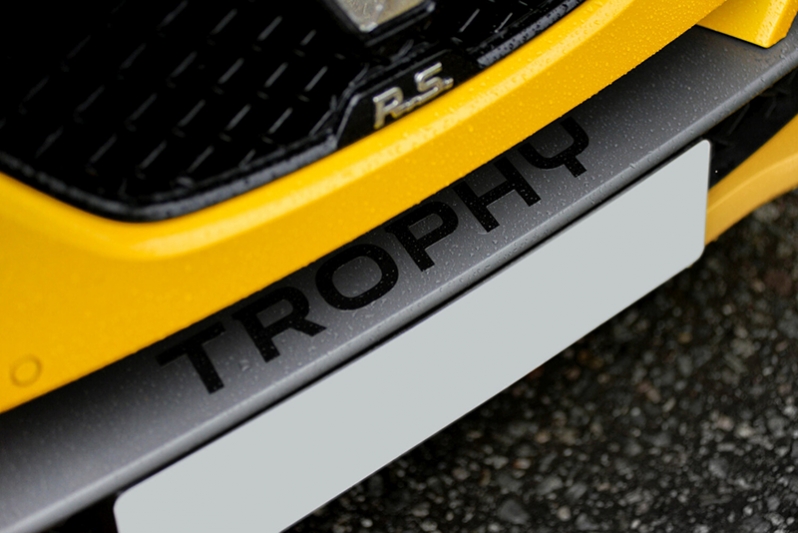
A few exploratory stabs of the throttle brings to life one of the more charismatic performance four-pots in production today. The Megane’s 1.8-litre engine gains a larger turbocharger and a freer-flowing exhaust system that gives it 20 more horsepower and 30 more Nm of torque, though to be fair it’s hard to tell the extra grunt over the regular RS without a side-by-side comparison. What is apparent though, is that 300hp and 420Nm is a potent sum no matter which way you slice it, with plenty of shove in the mid-range yet retaining decent energy when you run it out to its 7,000rpm rev limiter.
That’s certainly something commendable, and so is the hard-edged engine note, but what’s even more memorable is what happens when you stop accelerating and lift off the throttle: an absolutely glorious fusillade of cracks and crackles cascade from the central tailpipe, like the sound of not-so-distant gunfire. If you’ve ever been at Mandai Road or the Crematorium while a live firing session is happening at the Nee Soon Camp range, that’s not too far off what the Megane Trophy’s exhaust sounds like. If that doesn’t at least crack a smile on your face, then you might actually be dead inside…
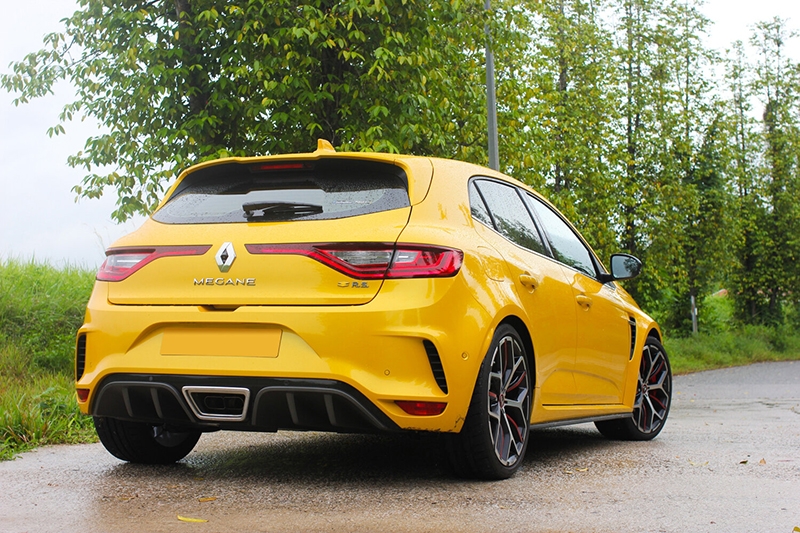
It doesn’t take long to notice there’s a definite edge to the Trophy over the standard car in the way it moves down a road. At normal, around-town speeds, there’s more jostling and head-bobbing occurring when driving over patched-up roadworks, potholes and expansion joints - a result of 25% firmer dampers, 30% firmer springs, and 10% firmer sway bars (a setup identical to the not-available-in-Singapore Cup chassis, which in other markets is an option on the regular RS).
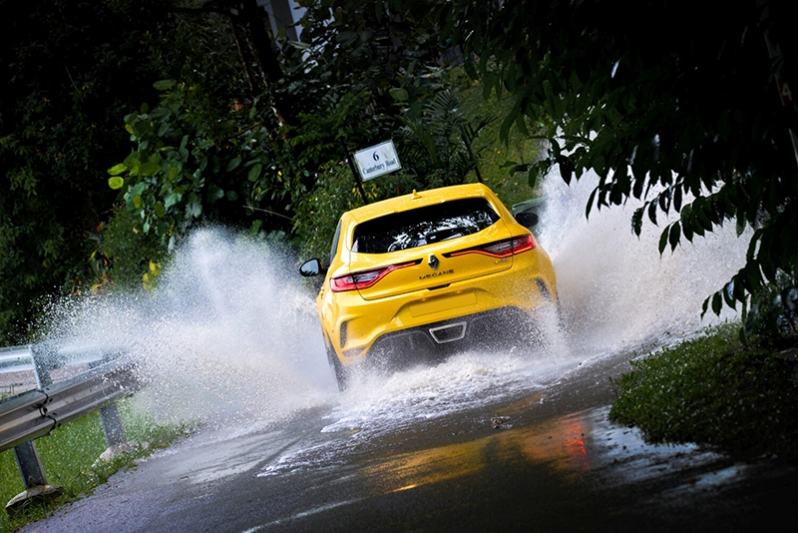
Yet once you up the pace and start putting some proper loads through the chassis, the Trophy comes into its own. That lumpy secondary ride transforms into unflappable body control, where bumps simply have no effect on the tyres’ contact with the tarmac no matter how loaded the suspension is. Rally-inspired hydraulic bump stops provide an uncanny amount of pliancy when the suspension reaches the end of its travel, and mean you never have to worry about the car thumping into the bump stops and suddenly jolting all out of shape, but so well-calibrated is the damping on the passive shock absorbers that they’re rarely truly called into action.
Even more impressive than that is what happens when you start tossing the Trophy around. Without the safe confines of a race track, it’s not easy to pinpoint the exact dynamic differences over the standard car, but whatever can be experienced within the envelope of fast road driving is no less bewitching than before. Where the exhaust was merely smile-inducing, the handling will first have your eyes out on stalks, then bring out a face-splitting grin.
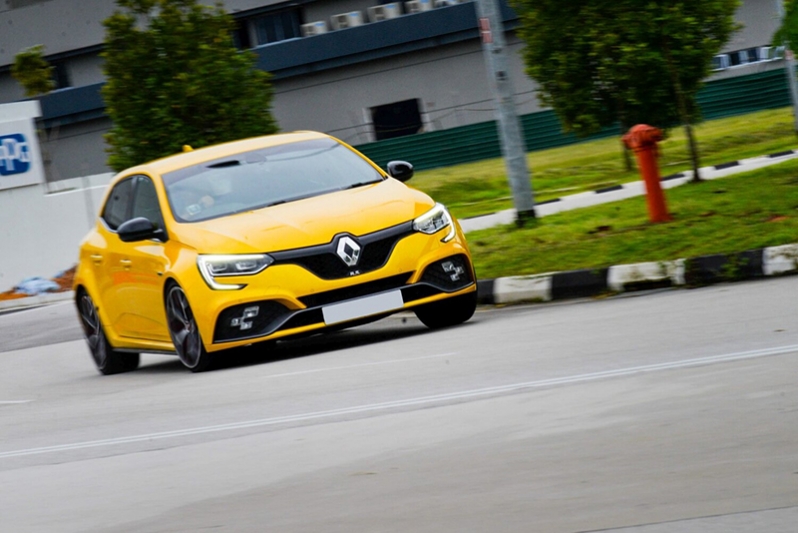
As a result of the 4Control system and hyper-quick steering rack, there are peculiarities to tackling corners in the Megane that you won't find in other cars. Approach them in the conventional way for a front-drive car - trail braking and turning in slightly early in anticipation of the front end’s inertia - and you’ll quickly find yourself see-sawing the wheel to avoid clouting the inside kerb or mowing the grass.
Instead, you need to drive it a bit like a Porsche 911 - brake neatly in a straight line and turn in late. In slower corners, it feels like the Trophy turns in in two phases: first comes the momentary inertia of front tyres working to rotate a FWD platform with a slightly portly 1450kg kerbweight, then a fraction later the rotation catches a second wind as the rear-steer hooks up and pushes the tail out, pivoting the nose towards the exit.
At first, this sensation of almost-but-not-quite oversteering messes with your head (your inner ear insists you need to countersteer but your eyes say otherwise), but once you get used to the more minute and sensitive inputs you need to make, you can then revel in the astonishingly neutral attitude the Trophy adopts during the apex and track-out phase of corners, which consequently means you can get on the power far earlier than other FWD cars. Such hilarious adjustability also means lurid tail-out action is easily achieved as well, which means that no matter whether you drive neat n’ tidy or fast n’ loose, the Trophy is guaranteed to entertain.
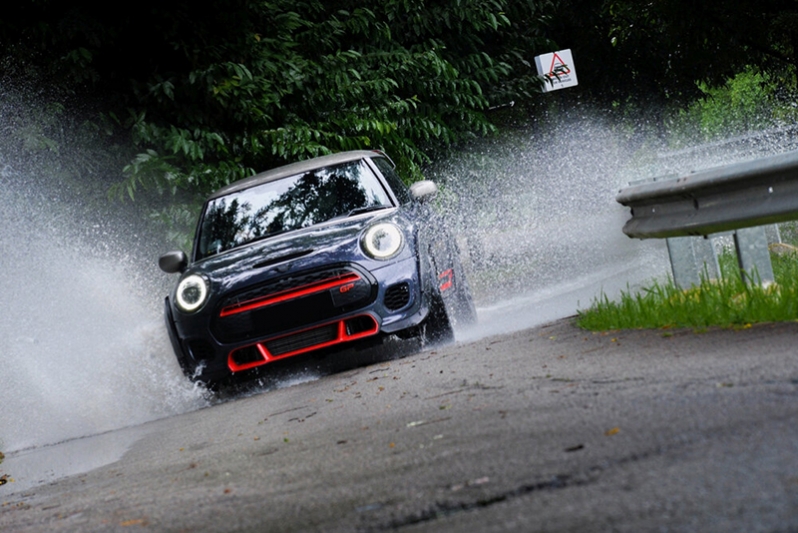
After that mental scrambling, hopping over to the Mini seems mildly disappointing. For all the bluster kicked up by its outrageous styling elements, the Mini’s drivetrain just isn’t all that characterful, with a synthetic-sounding engine note and muted exhaust that belies the two cannons poking out from beneath the rear bumper. It’s the first of the GP’s many contradictions - but we’ll get to those in a bit.
It’s certainly not lacking in pace. The 306hp and 450Nm from its 2.0-litre four-cylinder (the same B48 unit as used in the JCW Clubman/Countryman and BMW M135i) just pips the Megane’s outputs, but thanks to the highly efficient 8-speed auto it’s attached to, completes the century sprint in a faintly ridiculous 5.2 seconds - half a second faster than the Trophy - and making it possibly the fastest-accelerating production front-drive car ever.
As you’d expect given numbers like that, the Mini’s acceleration feels absolutely feral, even next to the Trophy. The harder punches are partially thanks to a chunk less weight (1255kg, or about 200kg less), but also thanks to shorter gear ratios. By now we’re fairly used to seeing 300+hp in the larger C-segment hatches, but in a car this small, that figure feels absurd. You’d best be holding on tight to something when you stomp on the GP’s loud pedal, because it feels like you’re holding on to a bucking bronco - and not just figuratively.
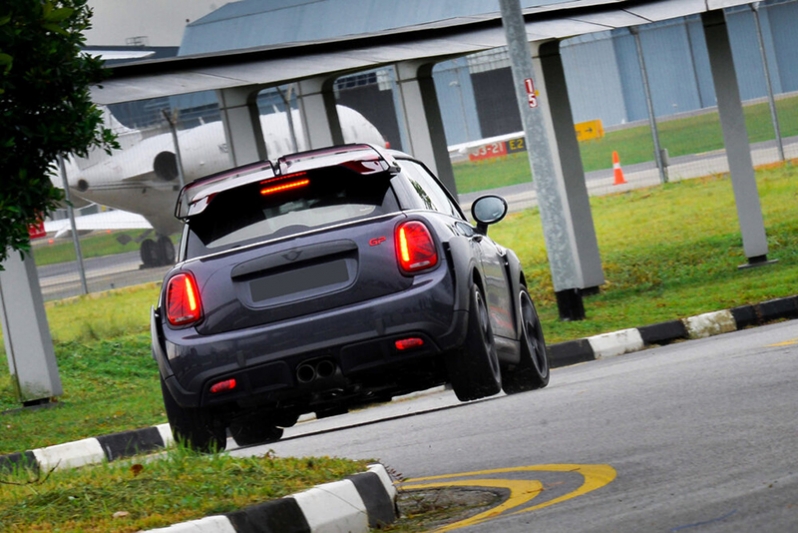
The Mini makes a good attempt at proving that you can have too much of a good thing. The 225/35R18 tyres (wrapped around rather attractive forged four-spoke wheels) struggle to keep a lid on all that prodigious grunt, with your attention diverted by either a furiously blinking traction control light or axle hop off the line. And, if you’re on anything other than a glass-smooth road, a third distraction: the steering wheel trying to squirm this way and that over tiny bumps and cambers, pulling the car all over the lane. A rather firm (potentially white-knuckled) grip really is required to keep the GP on the straight and narrow.
In the corners it’s a similar kind of situation; more often than not you finding yourself hanging on to the wheel for dear life, but for a slightly different reason. The GP grips and grips and grips, to the point that sometimes you’d wonder if a full race bucket seat really ought to be made standard to stop you tumbling all over the cabin.
Take the GP by the scruff of its neck and you’ll find that its nose has an almost hyperactive relationship with the steering, body roll is completely non-existent, and on the road at least, absolutely no manner of trail braking, lift-off oversteer or Scandinavian Flicks is capable of unsticking the rear end. It’s a departure from the cheeky, frisky nature we’ve come to expect of Minis, and when combined with the immediacy and total lack of slop in its responses, makes the GP feel distinctly Germanic, straight-laced and serious, like a 3-door Mini-shaped lump of Racing Grey granite. You get the distinct impression the GP would have far more opportunities to express itself on a racetrack, but on public roads, you’re more often than not just along for the ride.
This un-Mini like behaviour comes about thanks to extra chassis bracing, a 10mm lower ride height, increased camber, beefier anti-roll bars, and that widened track. Not, as it turns out however, the big red bar behind the front seats, which doesn’t actually brace the chassis; it’s just there ostensibly to prevent the contents of the boot joining you up front, although the lack of any sort of netting means there’s nothing stopping anything smaller than a backpack from slipping past. So much for authenticity...
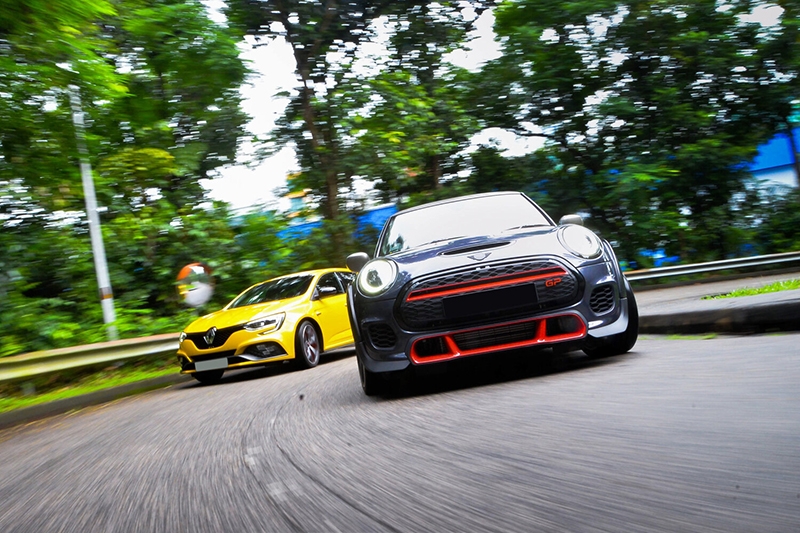
It’s a letdown that exemplifies the GP’s identity crisis. Is it a track-focused special, or is it just window dressing? The unflappable handling, bonkers aero devices and lack of rear seats seem to back up the former, but it’s countered by the surfeit of power, lack of aural drama, and ineffectual cross-brace. Such contradictions unfortunately bring out the cynic in me, suggesting that turning heads on the street was at least as important a development goal as turning laps on the racetrack.
In contrast, the Trophy has a depth about it that keeps inviting you to dig deeper, and reminds us why Renaultsport has been such a consistent master of hot hatchery. The Megane RS’s handling may be opinion-splitting, but you can’t deny Renaultsport was pushing the envelope of what’s possible in a front-drive car, nor the engineering legitimacy of bona fide tech like 4Control and those hydraulic bump stops.
With me having had such an intense previous experience in the standard Megane RS, perhaps the GP went into this fight with one hand already tied behind its back; that it couldn’t prove itself on a track probably tied up the other hand. But for better or worse, driving the Trophy hard will never fail to leave an impression, and for me, it just happens to be everything I look for as a driver. Either way though, both these cars are a high-water mark in the annals of (relatively) accessible performance, and anyone who owns one in Singapore is a surefire winner for being able to experience them.
